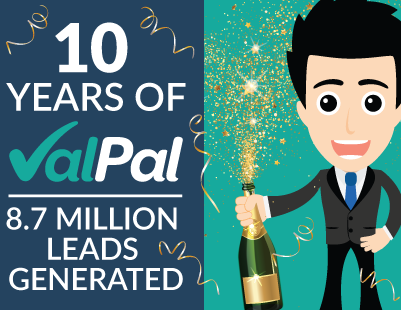Here’s an unusual story, describing the work of one of Purplebricks’ Local Property Experts who was with the company for around 18 months before leaving last year.
Ian Foster, who now runs his own business in Cornwall unconnected with property, approached Estate Agent Today to give an inside story of life as an LPE; it’s a very fair well-rounded description of the job and the working atmosphere, with much that he likes as well as those aspects that eventually led him to quit the position.
Although this is his personal experience of Purplebricks, Ian has also worked with a High Street agency and as a US realtor so ‘knows his way around’ agency. We’ve interviewed him because few former LPEs go on record, and because of the industry’s enduring interest in how Purplebricks and other online agencies work.
Ian worked for the agency from February 2017 until July 2018 covering, at different times, parts of Cornwall, Devon and Somerset; he says the patch for which he had responsibility varied partly as numbers of instructions varied, and partly dependent on his and other LPEs’ conversion rate.
The company, he says, set a target of 40 per cent conversion of visits to instructions and he averaged around 50 per cent. “Because the training at Purplebricks was so good, it was not really difficult to hit 40 per cent” although he says conversion rates amongst other LPEs varied from around 35 per cent right up to 75 per cent.
One aspect of the company’s approach that he liked in principle was so-called “underpinning” - this was effectively a form of guarantee that an LPE would take home (in his case) £2,000 a month even if their actual conversion rate fell lower. “They really look after you in that regard” he says.
The training itself, as has been widely reported in the trade press, involves two weeks, usually at the company’s Midlands headquarters. Ian was one of around 32 being trained in one group at the time.
“They were very long days and the two weeks ended in a test. The first week is very intensive, all about ‘you’. It wasn’t unusual for people to break down a little, talk about their drinking or their drug taking or their affairs. The second week was in my opinion very high pressure, about the company and winning instructions mostly. It was relentless but extremely effective” he adds.
However, he says there was no training in how to manage accounts or run a business - which, as self-employed LPEs they had to do.
On the controversial topic of customer reviews, Ian describes extreme top-down pressure to secure good Trustpilot feedback from vendors - sometimes even from just those would-be vendors who had asked for a valuation from Purplebricks.
“At times around 80 per cent of the communication we got about customers was ‘get the Trustpilot, get the Trustpilot’. Most customers go three reminders by text or email and the LPEs were then asking them to review as well.”
If there was a problem - like the property not selling or a customer being unhappy about some aspect of the LPE’s progress-chasing - it was in Ian's experience “pretty common” for LPEs to refer upwards for agreement to refund the customer, or at least reduce their fee.
He estimates around 50 per cent of all Purplebricks instructions went on to actually complete their sales.
But despite suggestions to the contrary in some quarters, there was never any sign of any financial incentive being given to customers to provide positive reviews.
It was on the subject of the broader day-to-day work of the LPE that Ian explained why he ended his time with Purplebricks: it was in his experience, he says, “just relentless pressure.”
Partly this was down to LPEs needing to be working long hours to provide a good income. Ian himself says his annual salary was only around £26,000 at best, although he knew of “very very rare” examples of LPEs earning £40,000 or more.
His best month’s income was £2,700 before expenses - he had to pay for his own petrol and other running costs, and the west country patch he covered was partly rural so had substantial distances between customers, costing time and money.
“The problem was it became a 7am until 11pm job. It was relentless. You drive to the customers to win instructions, then you’re available all day long for customers to ask you questions - and they expected you to be a 24 hour service” he recalls.
“The company spoke about the importance of a work/life balance but in the end for me it was work, work, work. There was no balance if you wanted a decent income and to provide a good service to customers.”
The pressure was worsened, he says, because the company did not always have staff available for those customers who paid additionally for an accompanied viewings package, meaning the LPE was often called upon to step in.
However, Ian says it wasn’t always like that.
“When I started at PB the central support team was a joy, LPEs could call in and get answers and also help customers that way.” But then the system changed in late 2017. “LPEs were banned from calling in and had to email instead which slowed everything down hugely and hurt customer service a great deal. I wrote to Michael Bruce saying this was a bad move and that the LPE was an extension of the customer and all this did was hurt the customer but the decision stood.”
That total volume of pressure, increasing during his time with the firm, is why he estimates only four of the 32 people in his original training cohort are still with Purplebricks, and why his own accountant said to him: “Ian, I’ve never anyone with such high expenses for so little income.”
Ian left the firm in the summer of 2018 and gave 30 days notice but was instead asked to leave immediately after saying he would be moving on. He was paid his 30 days notice but did not have, he claims, any opportunity to say goodbye to his customers or to have a transition period passing business to a successor LPE.
Ian insists that Purplebricks is “an excellent concept” but suffers from too little support for customers and LPEs, and therefore risks over-promising to vendors.
He now works with his wife running a business unconnected with estate agency and property.











.png)


.jpg)
.jpg)





%20-%20IMAGE%20Client%20Accounting%20%E2%80%93%20what%20are%20your%20options.jpg)


.png)
.png)




Join the conversation
Jump to latest comment and add your reply
A great piece Graham, perhaps now trading standards who appear to be on steroids will at last look at the claims of Purplebricks that they complete on 80% of the properties they list. Your story underpins the fact that 50% of vendors pay money to have a cake pushed in their face, ie, they pay a fee upfront, and get nothing but to dive head first into a cake. 'Cakemissery'
In October 2017 I wrote a full article about online agents, in it I discussed Easy Property, Tepilo, Emoov, Housesimple, Hatched, Yopa and Purplebricks, I showed statistically that all of them completed on 50% of their listed sales or less, and that their cost base would kill them off. Easy property never got started and morphed into something else, Tepilo closed, Emoov closed (son of Emoov now opened) Housesimple appear to be on the brink and Hatched closed. This leaves Yopa and Purplebricks, well both of these are not making any money.
The bottom line is always the bottom line, list two properties, complete on only one. Any agent who says they can complete on 8 of the ten houses they originally list is misguided. And with the new wave of Trading standard protocol upon the industry, all agents traditional and online will need to be declaring their referral fees - which will for online agents prove very interesting.
I attach the first three pages of an article I wrote in October 2017, so the data is from that period - but my hypothesis about onliner's still holds true, over 40% of vendors pay for a service they never receive, and you can not run an estate agency with only 'Listers' doing the job of a manager a lister a negotiator, an administrator and a sales Progressor.
By 2020, traditional estate agents will be dead, and online estate agents will sell half of all property in the UK. Written by Andrew Stanton - (Estate Agency Insights & Strategies) Oct 2017
This is a common enough headline and I thought so too, until I looked at the facts and realised; no online agent is making a profit, many online agents are propped up by large, regular injections of fresh capital, and the mature online estate agency model has no asset base and so no brand value.
Let me explain my hypothesis, the business model behind traditional bricks and mortar estate agency is that they get revenue from, fees on completed house sales, usually on a no-sale, no fee basis. They also get further revenue from arranging mortgages and life cover and other insurances, or receiving fees for passing clients to providers of mortgages, revenues from solicitors for referring clients, and other add on services like the provision of EPC’s, etc.
Now suppose you want to start a brand new traditional estate agency, how much profit will it make and when? and how much does it cost to set up and run? Here are the figures; it costs 30k to acquire premises and kit the office out and have all the IT hardware, systems, and office furniture in place. Then it costs 18K a month to cover the overheads, for a team of four-sales people and their salaries, cars, website costs, and all other costs to run the office and sell properties.
A traditional agency trading 50-miles from the capital will then market and sell property in all price ranges, mostly from £200,000 to £600,000, and as the brand matures they may specialise in both the mid-range and the top end range £800,000 to £1.5M. On average they sell property at an average price of £360,000 and they charge 1.1% plus VAT, or around £4,000 plus VAT, £4,800 in total on a no-sale, no fee basis.
In the first 12-months of trading – Year One - if they sell a property day one, the cheque for the completed sale arrives five-months later, and as they spend the first month getting property stock on the market, it is in their second month real sales begin. So, after six-months of trading they have spent 30k on setting the office up and 108k on running costs, that’s 138k, and probably they have received only 5k in on commission from completed sales.
Over the next six-months their outgoings are another 108k, and the commission from completed sales dribbles in, plus VAT, at a rate of, 5k month six, 7k month seven, 10k month eight, 12k month nine, 14k month ten, 18k month 11, and 20k month 12, total 86k. So, 236k spent out, and 86k cash flow in. Profit; what profit? there is no profit, they are now minus 160k for the first year.
Over the next 12 months – Year Two - office costs are 19.5k a month, and income from completed sales is 26k a month. So 234k spent out, and 312k cash flow in. Profit; 78k for the second year. In the next 12 months – Year Three – office costs are 20k a month, and income from completed sales is 28k a month. So 240k spent out, and 336k cash flow in. Profit ; 96k for the third year.
And more importantly at the end of year three, true break-even is achieved, all the start-up capital, that £160,000 pumped in and ‘lost’ in year one, has been repaid and from here on in they have a profitable business standing on its own two feet, with no need for further injections of capital to keep it trading.
So, 160k ‘loss’ (start-up costs) in year one, plus the 78k profit year two, plus the 96k profit year three, means a 14k surplus on the venture after 36-months.
In next 12-months - Year Four – office costs are 20.8k a month, and income from completed sales is 30.8k a month. So, 250k spent out, and 370k cash flow in. Profit; 120k. So on a turnover of 370k generated solely from commission in from completed sales, a gross profit of 120k, or a 23% profit margin.
By year ten gross profit could be 400k. Now on this example I have purposely, not fed in the other revenue income streams, revenue from mortgages, life cover etc, because in the start-up phase, a lot of these income streams are neutralised by the start-up costs of an extra member of staff and new equipment, IT etc.
For instance, a mortgage advisor costs 40k to sit in an office, and will take a year to cover his basic cost, earning no profit, but in year three of doing business they might generate 80k of profit, similarly an estate agency might set up lettings, again it will not become profitable until it has 40-properties let and managed, and so it will produce a negative cash flow for its first period of trading, but in year ten could generate 250k of profit. In a mature 10-year model, financial services can add up to 40% gross profit to the business annually and lettings can add 30%.
So, if in year ten, selling property generated 400k gross profit from commission from completed property sales, moving on from the 120k of year four, then financial services would add 160k gross profit and lettings another 250k gross profit, plus solicitor introductions, re-mortgage business, new homes, so a total gross profit for the one office 800k plus.
Now, if you opened 10-cold start offices, two would not make great profit, two would make super profit and the rest would be a mixed bag, due to local competition, lack of a good sales team etc. But, in the real world, statistically a 10-office cluster of agents will constantly generate at least a collective 2.4M gross profit, which ties in with the notion that a single office in year seven of its development should produce a 234K profit. Having looked at the traditional estate agency model for generating wealth, there are three other important factors at play; most ‘traditional’ estate agents only charge a fee on exchange of contracts, so on a no-sale no fee basis; nationally, 50% of all the property that an estate agent lists (takes to the market) in a year they fail to sell; estate agents get paid huge commissions which is unfair.
The no payment until the job is done means that the agent is highly motivated to find a buyer; otherwise all the marketing costs are lost. Also, as their agency agreements are time specific as time passes, estate agents are more and more pressured to find a buyer before the vendor goes to a second agent.
The fact that half the property stock does not sell means that the fee charged by the agent actually covers, all the cost of the sales of the property that have exchanged, and all the cost of the properties they listed and failed to sell. So, list two properties, sell and exchange on one, lose the other, and the fee from the sold one covers the marketing costs of both, plus profit margin.
Interestingly, of the 50% of properties that are not sold by the first agent, over 60% of these are sold by the next or third agent instructed, so over 80% of property does get sold if it stays marketed. So, as an example if an estate agent generates 320k of revenue excluding VAT in a year, just from completed sales, that is, 80-completed sales at an average fee of £4,000 plus VAT, which is around 1.1% plus VAT of a 360k property sale price.
This £4,000 plus VAT fee is in fact covering the cost of selling the property and the cost of marketing another property that was never sold, (one of the dead loss 50% which they lose to the second or third agent). The old chestnut that the agent gets paid a huge commission is debatable.
Individual sales people may get a 5% or 10% commission of the fee, which is a huge incentive to sell the property, but their basic salary will be at a low level, and they will usually work at least a 50 to 60-hour week, and they will in the main be extremely skilled in their profession. So, if you start to work out their hourly rate, factor in their low basic salary and then factor in they earn commission at a rate before tax of either 5% gross of the £4,000 fee, so that’s £200, or 10% gives them £400, they are not going to be buying a yacht anytime soon.
Also, I have illustrated that the onerous office costs month in month out, also mean that many managers or owners earn a reasonable amount, but again there is little fat in the business. The vagaries of the market, government intervention on stamp duty, general elections, etc, can often skew trading patterns, so with a good team a mature estate agency might trade on a gross profit of 30% plus. But, many agents trade on a margin of less than 10%, despite being number one in their areas, which is not indicative of inflated commissions being charged.
Now, suppose you want to set up an online estate agency, how much profit will it make and when? And how much does it cost to set up and run? To my knowledge no online estate agency has yet made a penny profit as of October 2017, and some have been trading over eight-years.
So, I am going to look at Purplebricks (UK), to illustrate the online business model and give an insight into how they trade, as from what I can see all online models are a variant on this company. Purplebricks (UK) or (PB) is less than three years old, and follows in the footsteps of Hatched and Tepilo some of the original trailblazers which were created five-years or more earlier. (PB) ‘the property market disrupter’ are by far the biggest online estate agency, claiming they will make a profit of around 6M in 2019.
At present according to Rightmove, they nationally have over 28,000 properties listed online, over 16,000 for sale, and 12,000 under offer, an impressive tally. Though not profit making, they dwarf the online opposition in the number of properties they have online.
Their share price is through the roof, as they generate a huge amount of cash through put, but no profit has ever been made. (PB) charges £849 including VAT, to list your home, and £1,199 including VAT in London, and their intention is to sell the property, but the fee is fully payable should the property fail to sell, unlike the traditional estate agents no sale, no fee proposal.
On the surface the business model is low cost with many traditional estate agency elements stripped out, such as no bricks and mortar premises, and it is front end cash generative. There are no dedicated employed sales teams, as per the traditional estate agents, instead they have instruction getters or listers, termed Local Property Experts, (LPE’s) who are self-employed, and receive a commission per instruction listed.
They then earn additional commissions from selling add on products and services such as; accompanied viewings, conveyancing leads and financial services etc. A big part of their business model apart from the ‘low fee’ is that they advertise they do not charge a commission, just a fixed low fee. Well given that the LPE’s get an instant commission somewhere in the region of £400, per property listed, a fixed percentage of the overall fixed fee charged to the vendor.
This model strikes a strong chord with the traditional employed sales person sitting in a cosy office being paid £400 commission for a successfully sold and completed sales transaction. I wonder if vendors are aware that the nice young lady or gentleman sitting in front of them stands to personally earn an instant - £400 of the £900 plus VAT fee they are charging each time they get them to sign to sell, (even if the property fails to sell). I also wonder, and I know there is a Gig economy vibe out there, but will the tax man soon think these 450-people are really employed, rather than self-employed?
C+ Good effort but your peice has a to much bark and no bite. Also, a bit conceited to think anyone would actually read all 12 pages, don't you think? Stick to your day job; don't you have a parking ticket to write?
Too much bark.... C- Must try harder!
Reposting old articles from 2017 in their entirety is very naff and lazy.
"Then it costs 18K a month to cover the overheads, for a team of four-sales people and their salaries, cars, website costs, and all other costs to run the office and sell properties."
Your costing for an estate agent start up does not make sense. A brand new startup would not hire a team of 4 salesmen at the get go. That's something to aim for further down the line of course, but to begin with one salesman will do, with his own car.
An insider view indeed, from an outsider perspective it just looks like a busted flush
A busted flush sounds more like one of Andrew's rentals 😀
How boring was that and I skipped 9.5 pages as for his gigs for a cold start 10 office business, what poppycock
Thankyou Andrew for an interesting and very well thought out insight into our industry. That took a lot of time and effort to put that together.....much appreciated.
The failure of their model won't only be running out of investors funds or patience but the whole
comcept around a self employed member of staff being the only face to face point of contact. At last we are getting warmer with regards to The Purplepricks real conversion rate and I would have a bet with the Bruce's that it's not more than 45%... name your stake Bruces.
One thing this LPE fails to mention is the initial interview process.. a oneway Skype video call where they can see you and you can't see them because they are obviously filming you.
So in short they look after their self employed staff as well as they look after their clients and cash in and Trustpilot reviews is what they live for... what a model that Neil Woodford and his fund must be so proud of ... I am just glad a close friend from Artemis told them where to go when PB pitched their business to them some 5 years ago... on the back of my advice..
Thanks Andrew. Really interesting to read the different profit models.
It would be easier to read if the article had a little formatting. Perhaps the @AngelsMedia team can help out?
Andrew I was led to believe the LPEs get closer to £250 (+vat) but I doubt they are vat registered as I can't see them
Earning over £50k per annum, unlike PB's other misleading advertising would suggest... £100k OTE have you seen the 100's of adverts on LinkedIn and indeed! They are fast becoming the Foxtons of the internet.. over charge clients, heavy turnover of staff but whom will be the first to crack in their fee structure or going bust... Place your bets...
How long until we see the new option on their website that they can choose to list the property without an LPE for a reduced fee.
PB need to give away £X and have the hassle of staff (sorry self employed) - The majority of their clients are penny pinchers so they are not really bothered about service.
Sounds like REMAX all over again !!
If they are all self employed why don't rightmove charge each LPE as a seperate business instead of subsidising them?
Are they not ????
That's a typical Rightmove ploy
smile please - I think that will be the final pb model - self listing.
the other thing to look out for is this - with referral fees about to be the hot topic - will pb have to become transparent?
In that will the self employed lpe have to say to each new prospective vendor 'mr vendor I get an immediate 250 pound fee when i sign you up as an instruction' 'I was referred your information from a multi million pound intial tv and online spend by a separate company pb' 'I also give pb a 750 pound plus portion of your fee as a referral fee for their service to me' - anyone at trading standards in Powys like to comment?
Lpes only get £150 a listing outside of London the territory owners pocket £50 per listing for owning the postcode. Unless you have no children partners or social life making good money Is impossible.
Please login to comment